Measuring the Speed of Waves
1/39
There's no tags or description
Looks like no tags are added yet.
Name | Mastery | Learn | Test | Matching | Spaced |
|---|
No study sessions yet.
40 Terms
What are the three methods to determine the speed of sound
Method 1: Measuring Sound Between Two Points
Method 2: Using Echoes
Method 3: Using an Oscilloscope
How many steps are there in Method 1? Measuring the speed of sound directly between two points
6
Step 1 (Method 1 Measuring the speed of sound directly between two points)
Two people stand a distance of around 100 m apart
Step 2 (Method 1 Measuring the speed of sound directly between two points)
The distance between them is measured using a trundle wheel
Step 3 (Method 1 Measuring the speed of sound directly between two points)
One person has two wooden blocks, which they bang together above their head
Step 4 (Method 1 Measuring the speed of sound directly between two points)
The second person has a stopwatch which they start when they see the first person banging the blocks together and stops when they hear the sound
Step 5 (Method 1 Measuring the speed of sound directly between two points)
This is then repeated several times and an average value is taken for the time
Step 6 (Method 1 Measuring the speed of sound directly between two points)
The speed of sound can then be calculated using the equation: speed of sound = distance traveled by sound/time taken

List the entire method 1 Measuring the speed of sound directly between two points
Two people stand a distance of around 100 m apart
The distance between them is measured using a trundle wheel
One person has two wooden blocks, which they bang together above their head
The second person has a stopwatch which they start when they see the first person banging the blocks together and stops when they hear the sound
This is then repeated several times and an average value is taken for the time
The speed of sound can then be calculated using the equation: speed of sound = distance traveled by sound/time taken
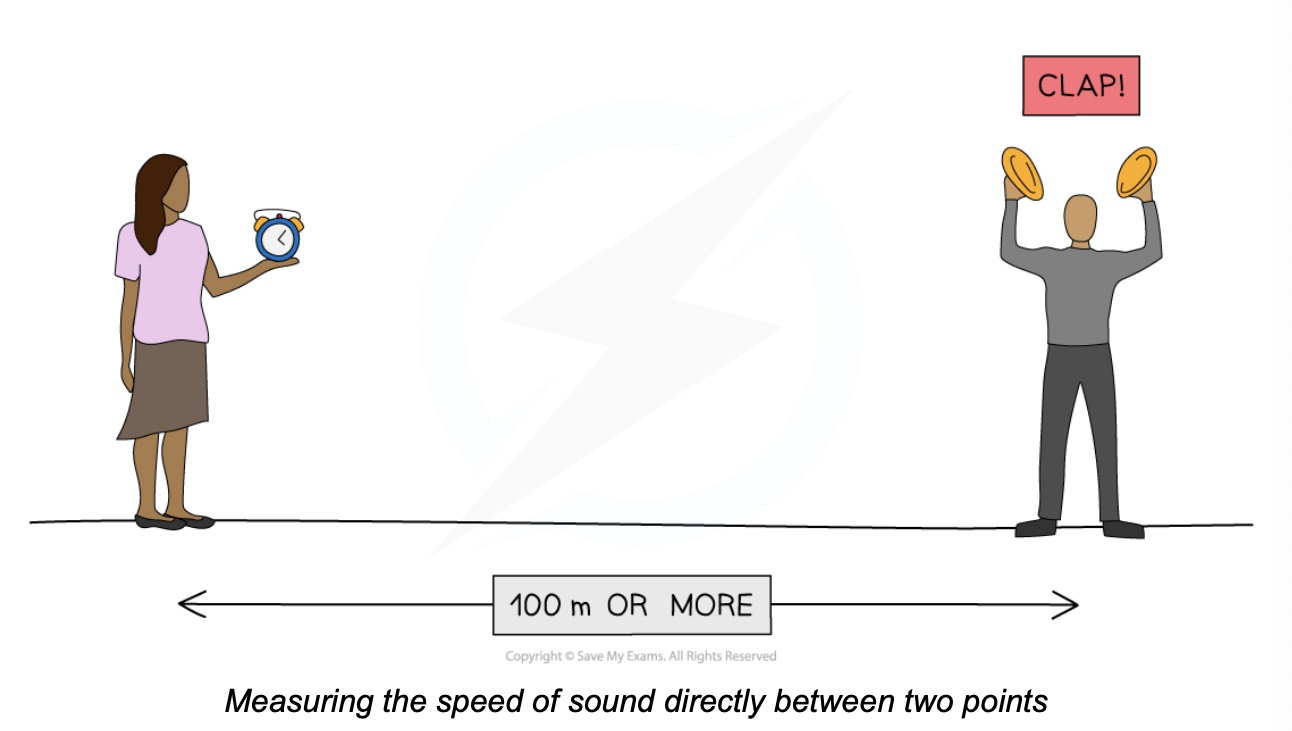
How many steps are there to Method 2: Measuring the speed of sound using echoes
8
Step 1 (method 2 Measuring the speed of sound using echoes)
A person stands about 50 m away from a wall (or cliff) using a trundle wheel to measure this distance
Step 2 (method 2 Measuring the speed of sound using echoes)
The person claps two wooden blocks together and listens for the echo
Step 3 (method 2 Measuring the speed of sound using echoes)
The person then starts to clap the blocks together repeatedly, in rhythm with the echoes
Step 4 (method 2 Measuring the speed of sound using echoes)
A second person has a stopwatch and starts timing when they hear one of the claps and stops timing 20 claps later
Step 5 (method 2 Measuring the speed of sound using echoes)
The process is then repeated and an average time calculated
Step 6 (method 2 Measuring the speed of sound using echoes)
The distance travelled by the sound between each clap and echo will be (2 × 50) m
Step 7 (method 2 Measuring the speed of sound using echoes)
The total distance travelled by sound during the 20 claps will be (20 × 2 × 50) m
Step 8 (method 2 Measuring the speed of sound using echoes)
The speed of sound can be calculated from this distance and the time using the equation: speed of sound = 2 x distance to wall/time taken

list the entire method 2 Measuring the speed of sound using echoes
A person stands about 50 m away from a wall (or cliff) using a trundle wheel to measure this distance
The person claps two wooden blocks together and listens for the echo
The person then starts to clap the blocks together repeatedly, in rhythm with the echoes
A second person has a stopwatch and starts timing when they hear one of the claps and stops timing 20 claps later
The process is then repeated and an average time calculated
The distance travelled by the sound between each clap and echo will be (2 × 50) m
The total distance travelled by sound during the 20 claps will be (20 × 2 × 50) m
The speed of sound can be calculated from this distance and the time using the equation:
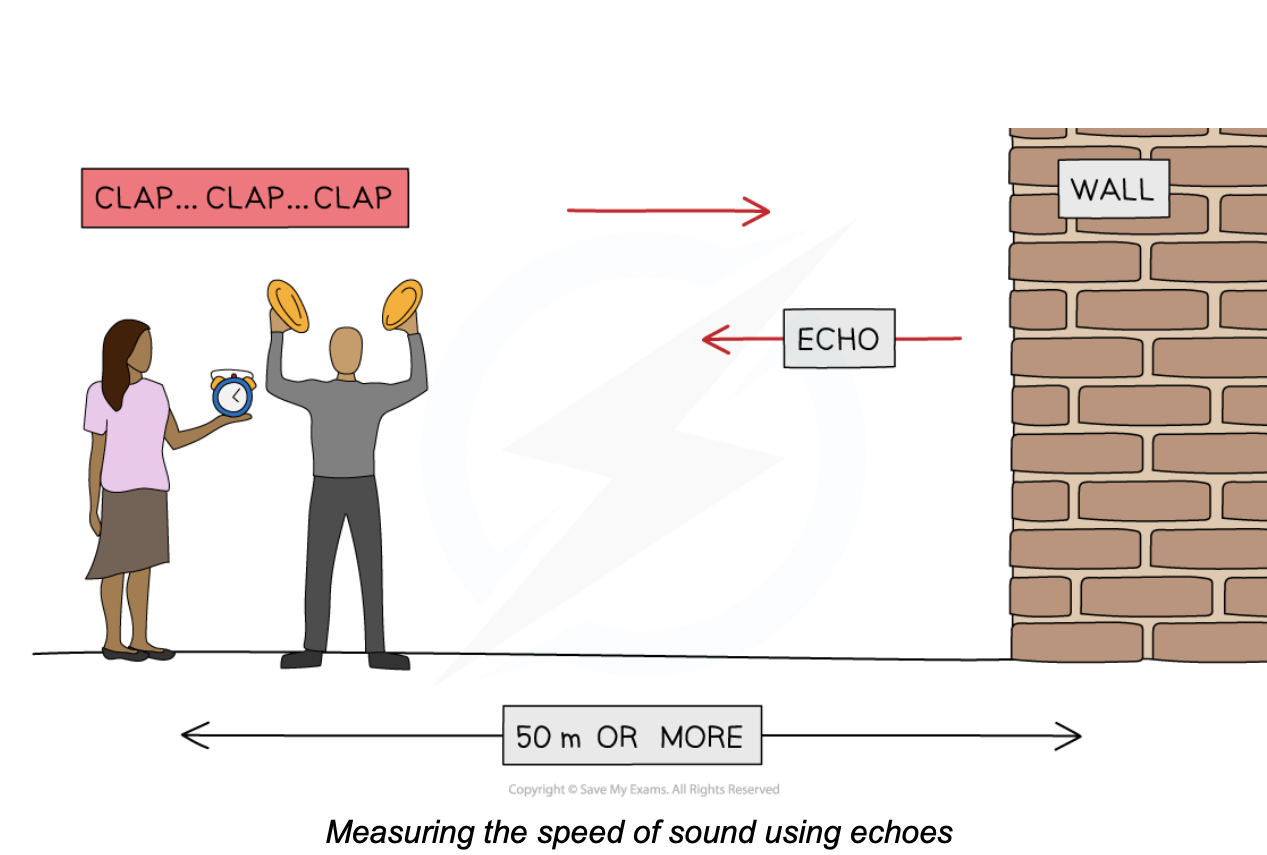
how many steps are there to method 3 Measuring the speed of sound using an oscilloscope
6
step 1 (method 3 Measuring the speed of sound using an oscilloscope)
Two microphones are connected to an oscilloscope and placed about 5 m apart using a tape measure to measure the distance
step 2 (method 3 Measuring the speed of sound using an oscilloscope)
The oscilloscope is set up so that it triggers when the first microphone detects a sound, and the time base is adjusted so that the sound arriving at both microphones can be seen on the screen
step 3 (method 3 Measuring the speed of sound using an oscilloscope)
Two wooden blocks are used to make a large clap next to the first microphone
step 4 (method 3 Measuring the speed of sound using an oscilloscope)
The oscilloscope is then used to determine the time at which the clap reaches each microphone and the time difference between them
step 5 (method 3 Measuring the speed of sound using an oscilloscope)
This is repeated several times and an average time difference calculated
step 6 (method 3 Measuring the speed of sound using an oscilloscope)
The speed can then be calculated using the equation: speed of sound = distance between microphones/time between peaks

list all steps to method 3: Measuring the speed of sound using an oscilloscope
Two microphones are connected to an oscilloscope and placed about 5 m apart using a tape measure to measure the distance
The oscilloscope is set up so that it triggers when the first microphone detects a sound, and the time base is adjusted so that the sound arriving at both microphones can be seen on the screen
Two wooden blocks are used to make a large clap next to the first microphone
The oscilloscope is then used to determine the time at which the clap reaches each microphone and the time difference between them
This is repeated several times and an average time difference calculated
The speed can then be calculated using the equation: speed of sound = distance between microphones/time between peaks
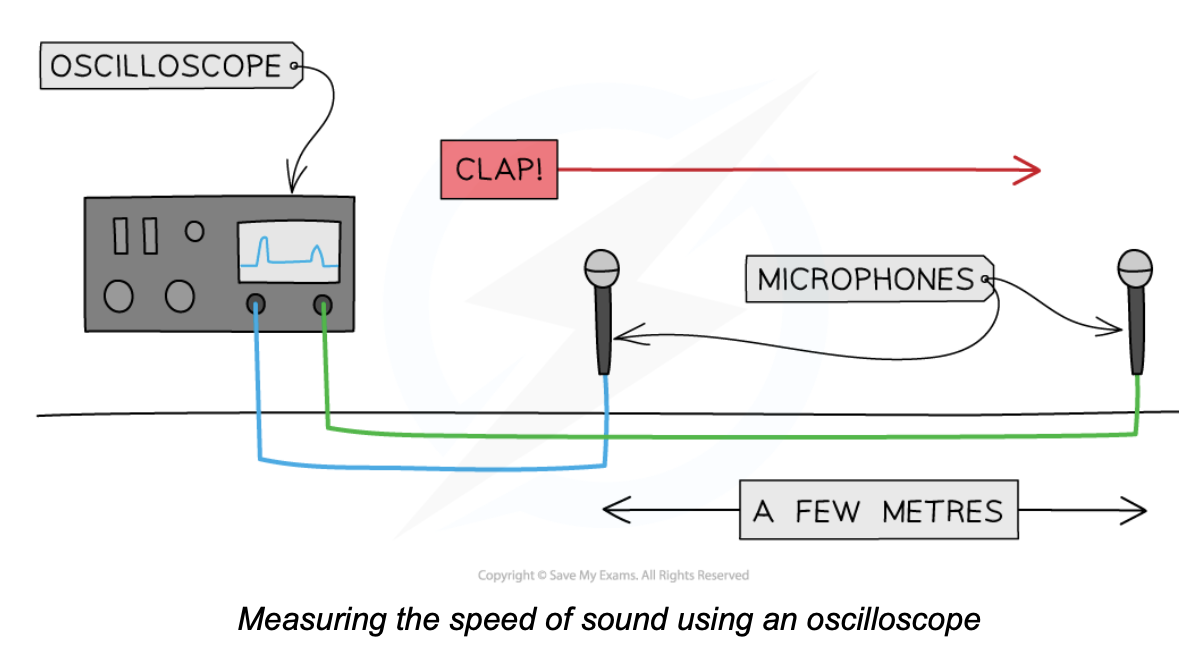
how many steps are there to method 4: Creating ripples in water
6
step 1 (method 4: Creating ripples in water)
Choose a calm flat water surface such as a lake or a swimming pool
step 2 (method 4: Creating ripples in water)
Two people stand a few metres apart using a tape measure to measure this distance
step 3 (method 4: Creating ripples in water)
One person counts down from three and then disturbs the water surface (using their hand, for example) to create a ripple
step 4 (method 4: Creating ripples in water)
The second person then starts a stopwatch to time how long it takes for the first ripple to get to them
step 5 (method 4: Creating ripples in water)
The experiment is then repeated 10 times and an average value for the time is calculated
step 6 (method 4: Creating ripples in water)
The average time and distance can then be used to calculate the wave speed using the equation: average speed = sdistance moved/time taken

list all steps in method 4: Creating ripples in water
Choose a calm flat water surface such as a lake or a swimming pool
Two people stand a few metres apart using a tape measure to measure this distance
One person counts down from three and then disturbs the water surface (using their hand, for example) to create a ripple
The second person then starts a stopwatch to time how long it takes for the first ripple to get to them
The experiment is then repeated 10 times and an average value for the time is calculated
The average time and distance can then be used to calculate the wave speed using the equation:
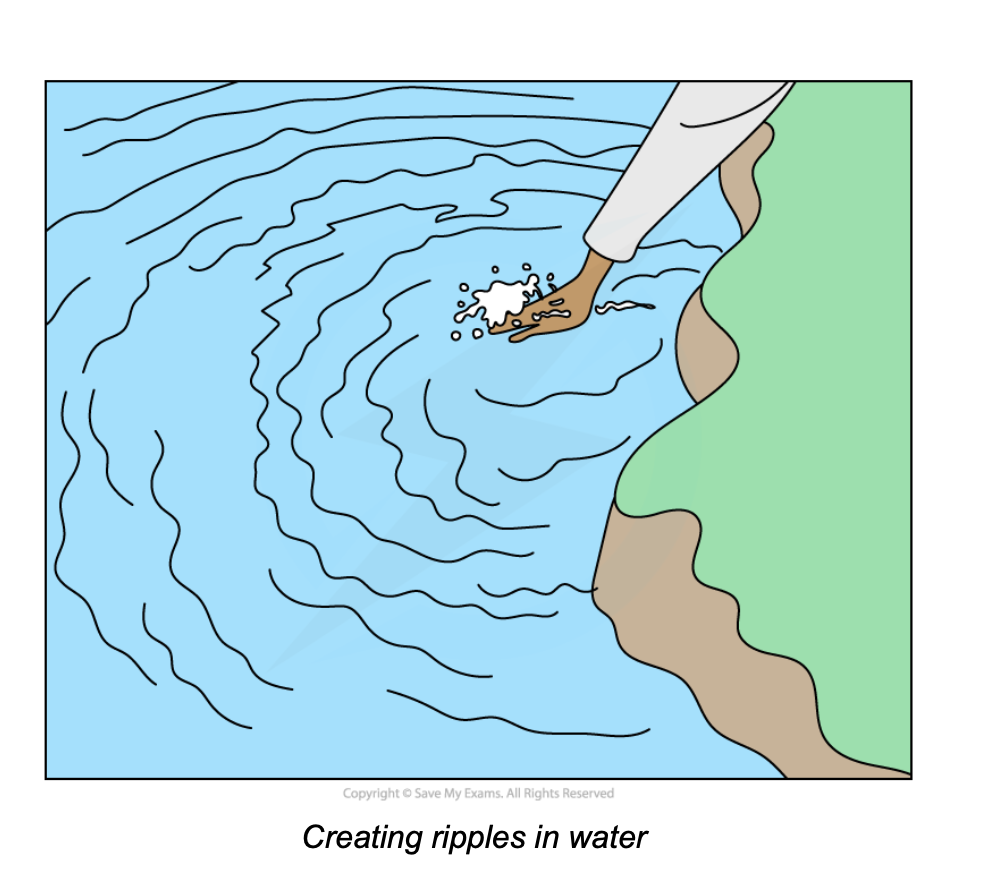

Small water waves are created in a ripple tank by a wooden bar. The wooden bar vibrates up and down hitting the surface of the water. The diagram below shows a cross-section of the ripple tank and water.Which letter shows:
a) The amplitude of a water wave?
Step 1: Recall the definition of amplitude
Amplitude = The distance from the undisturbed position to the peak or trough of a wave
Step 2: Mark the undisturbed position on the wave
This is the centre of the wave
Step 3: Identify the arrow between the undisturbed position and a peak
The amplitude is arrow D

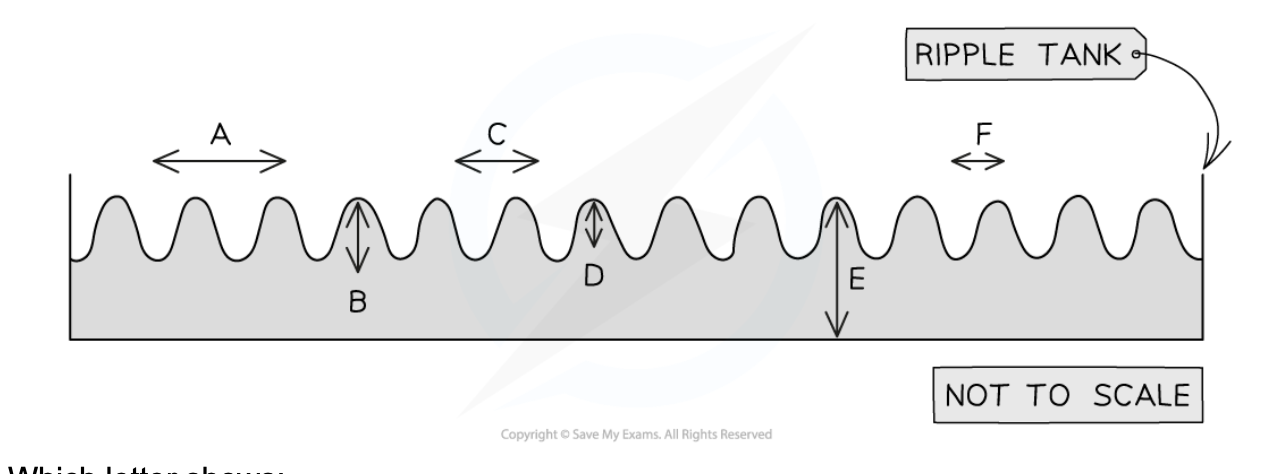
Small water waves are created in a ripple tank by a wooden bar. The wooden bar vibrates up and down hitting the surface of the water. The diagram below shows a cross-section of the ripple tank and water.Which letter shows:
b) The wavelength of the water wave?
Step 1: Recall the definition of wavelength
Wavelength = The distance from one point on the wave to the same point on the next wave
Step 2: Draw lines on each horizontal arrow
This helps to identify the points on the wave the arrows are referring to
Step 3: Identify the arrow between two of the same points on the wave
The wavelength is arrow C

What would be the most and least accurate method in the case of measuring the speed of sound?
In the case of measuring the speed of sound:
Method 3 is the most accurate because the timing is done automatically
Method 1 is the least accurate because the time interval is very short
Why would using a manual stopwatch decrease the accuracy of a method? (3)
For example, if a manual stopwatch is being used there could be variation in the time measured which can be up to 0.2 seconds due to a person's reaction time
The time interval could be as little as 0.3 seconds for sound travelling in air
This means that the variation due to the stopwatch readings has a big influence on the results and they may not be reliable
How would you make a method better
use bigger distances